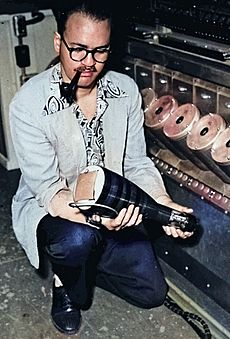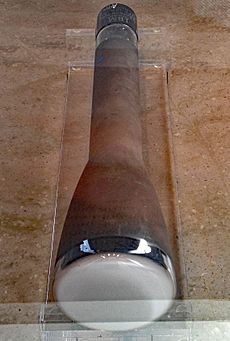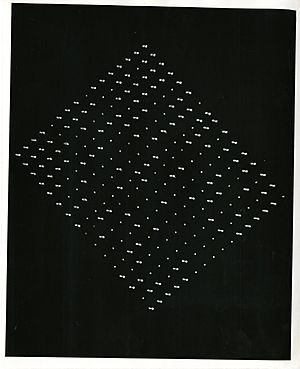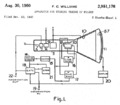Williams tube facts for kids
The Williams tube, also known as the Williams–Kilburn tube, was an early type of computer memory. It was named after its inventors, Freddie Williams and Tom Kilburn. This was the very first device that could store digital information in a random-access way. This means the computer could quickly get to any piece of information it needed, without having to go through everything else first. Williams tubes were used successfully in some of the first computers ever built.
This special tube worked by showing a pattern of dots on a cathode-ray tube (CRT), which is like an old TV screen. When the electron beam hit the screen, it created a tiny bit of static electricity at each dot. A thin metal sheet in front of the screen could "read" these tiny charges. Because the dots would fade away over time, the system had to redraw them often to keep the information safe. Williams tubes were much faster than older memory types, like acoustic delay lines. This was because they worked at the speed of electrons, not the speed of sound. However, they could be affected by other electrical signals nearby and often needed to be adjusted. Williams–Kilburn tubes were mostly used in computers that needed to be very fast.
Williams and Kilburn first applied for patents in Britain in 1946 and 1947. They then applied for patents in the United States in 1947 and 1949.
Contents
How the Williams Tube Works
The Williams tube uses a special effect that happens in cathode-ray tubes (CRTs). When a beam of electrons hits the screen (which is covered in a material called phosphor), it usually makes the screen light up. If the electron beam is strong enough, it also knocks out some electrons from the phosphor. These knocked-out electrons move a short distance before falling back onto the screen nearby.
This process creates a small area on the screen where there are fewer electrons, making it slightly positive. Around this positive spot, there's a slightly negative area where the extra electrons landed. This "charge well" stays on the screen for a very short time before the electrons move back to where they started.
Storing Information (Writing)
Creating these charge wells is how the Williams tube stored information, like a single binary digit (a "bit," which is either a 0 or a 1).
- To store a "1," the electron beam would create a positive dot.
- To store a "0" (or erase a "1"), the beam would draw a second dot right next to the first one. The negative area around the second dot would fill in the positive center of the first dot, making it disappear.
Often, a row of dots or empty spaces on the screen would represent a whole "word" of computer data. If the electron beam was stronger, the dots would be bigger and last longer. But this also meant the dots had to be placed further apart so they wouldn't accidentally erase each other.
Each Williams tube could usually hold about 256 to 2560 bits of information. Because the electron beam can move very quickly to any spot on the screen, the computer could access any piece of data directly. This is what "random access memory" means. To find a piece of data, the computer would tell the tube where to look using X and Y coordinates.
Getting Information (Reading)
Reading information from the memory worked because of a side effect of the writing process. When a dot is created, the movement of charges in the screen creates a tiny electrical current. This current can be picked up by a thin metal sheet placed in front of the screen.
- When the computer wanted to "read" a spot, the electron beam would try to "write" to that spot again.
- If the spot already had a "1" (a positive charge), no new current would flow, and the metal sheet would detect nothing. This told the computer it was a "1."
- If the spot had a "0" (no charge), the new "write" would create a charge well, and the metal sheet would pick up a small electrical pulse. This told the computer it was a "0."
An important thing to remember is that reading a spot would always create a charge well, even if there wasn't one before. This meant that reading a piece of data would destroy the original information there. So, after reading, the computer had to immediately rewrite the original data back to that spot to save it. Some systems even used a second electron beam to help with this.
Keeping Information Fresh (Refreshing)
Since the dots on the screen would fade away over time, the entire screen had to be "refreshed" regularly. This meant reading all the data and then immediately rewriting it back. This refreshing could happen automatically by other parts of the computer while the main computer (the central processing unit or CPU) was busy doing other tasks. This is similar to how modern DRAM (a type of computer memory) needs to be refreshed.
Clearing Information (Erasing)
Because the refresh process kept redrawing the same pattern, there needed to be a way to erase old information. This was usually done by writing a new dot right next to the old one. The electrons released by this new dot would fill in the "charge well" of the old dot, making it disappear. Early systems did this by drawing a short "dash" instead of a dot, which was an easy way to erase.
Seeing the Data
Some Williams tubes were made from old radar screens that had a special coating (phosphor) that made the dots visible. Other tubes were made just for memory and didn't have this coating. Whether the data was visible or not didn't affect how the tube worked, and operators usually couldn't see it anyway because the metal pickup plate covered the screen. If someone needed to see the data, a second tube (without the pickup plate) would be connected to show what was being stored.
How the Williams Tube Was Developed
The Williams tube was created at the University of Manchester in England. It was used as the memory for the Manchester Baby, which was the very first electronic computer that could store and run a program. This computer successfully ran its first program on June 21, 1948. The Manchester Baby was actually built to test how reliable the Williams tube memory was. Tom Kilburn wrote a short program (only 17 lines long!) to find the largest factor of numbers up to 218. It's said that this was the only program Kilburn ever wrote.
Williams tubes often became less reliable as they got older and usually needed to be adjusted by hand. Other types of early memory, like mercury delay-line memory, were slower and couldn't access data randomly. However, delay lines didn't age as badly and were used in some early computers, even though they had issues with speed, weight, cost, heat, and even being toxic.
The Manchester Mark 1, which used Williams tubes, was later sold as a commercial computer called the Ferranti Mark 1. Some early computers in the United States also used Williams tubes, including the IAS machine, the UNIVAC 1103, IBM 701, IBM 702, and the Standards Western Automatic Computer (SWAC). Williams tubes were also used in the Soviet Strela-1 and the Japan TAC (Tokyo Automatic Computer).
Images for kids
See also
- Atanasoff–Berry computer – Used a different type of memory called regenerative capacitor memory
- Mellon optical memory








